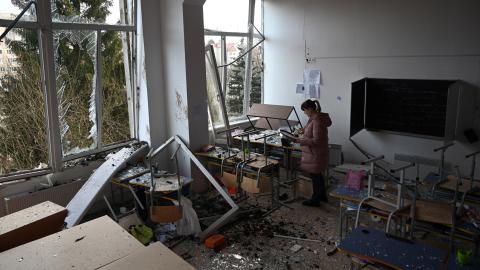Below Hudson Senior Fellow Can Kasapoğlu offers a military situation report about the war in Ukraine.
Executive Summary
- Despite Ukraine’s defensive efforts, Russian forces took the city of Avdiivka, a long-embattled flashpoint in Donetsk Oblast.
- Ukraine’s robotic warfare deterrent and coastal defenses continue to inflict heavy losses on Russia’s Black Sea Fleet.
- Russian forces intensified their efforts to dismantle Ukraine’s tactically important bridgehead along the Dnipro River near Krynky.
- Russian buildup on the Orikhiv front could soon lead to a move against the Robotyne bulge, Ukraine’s primary gain from its last counteroffensive.
1. Battlefield Assessment
Alarming changes in battlefield geometry occurred on several fronts last week. Open-source intelligence suggests that the Russian Armed Forces have either advanced or intensified offensive action in multiple locations, including Bakhmut, Marinka, and Krynky, the site of the tactically critical bridgehead that Ukrainian forces hold on the east bank of the Dnipro River. As in previous weeks, positional engagements took place in myriad other places along the front lines.
Russia also conducted drone and missile attacks across several regions of Ukraine, killing a large number of civilians and reportedly damaging residential buildings, businesses, and, according to local reports, kindergartens and educational institutions, echoing the early stages of the Russian invasion.
Reportedly, the missiles Russia used in these attacks included various types following different flight trajectories, including Kh-101 and Kh-555 air-launched cruise missiles, Iskander-M ballistic missiles, Kalibr sea-launched cruise missiles, Kh-59 guided air-launched missiles, and S-300 air-defense missiles modified for land-attack roles.
2. Avdiivka Falls to Russian Forces
Open-source imagery intelligence suggests that Russian combat formations made significant advances in Avdiivka, which brought an end to concerted Ukrainian defensive actions there. Over the last week, Russian forces captured several fortified strategic positions in and around the town. A tactically critical defensive position at Zenit, a former Soviet air defense complex, fell first, followed by the Avdiivka Coke Plant. Following these losses, Ukraine’s newly appointed commander-in-chief, General Oleksandr Syrskyi, ordered large-scale withdrawals to avert the total annihilation of his combat formations. General Syrskyi’s decision-making here differed notably from the calculations he made while commanding the fight for Bakhmut, where he demonstrated a greater willingness to incur casualties.
Given the favorable force-to-terrain and force-on-force ratios Russian forces have long held in the fight for Avdiivka, it is to their credit that Ukrainian forces held out for as long as they did. More than 95,000 Russian troops operate in Donetsk Oblast, dwarfing the Ukrainian forces that are around 50,000 strong. Russian artillery operations have also been running at an operational tempo ten times faster than that of Ukrainian fire-support units.
Nonetheless, the capture of Avdiivka is a victory for Russia, a victory on which the Kremlin will seek to build. Russia will conscript—and, if necessary, mobilize—hundreds of thousands of servicemen in 2024. Russian industry currently produces more than 100 main battle tanks per month. North Korea supplies the Russian military with a significant number of artillery shells, and Tehran continues to work with Moscow on a joint drone production plant in Tatarstan. There is no shortage of gunpowder, steel, and conscripts for the Russian elite to use now that Avdiivka has fallen.
Russian units now will likely turn their attention south, to the Orikhiv front, where they have already amassed forces that outnumber those used to take Avdiivka. A Russian assault on the Robotyne bulge, Ukraine’s primary gain from its once-promising counteroffensive, may be looming.
3. The Russian Black Sea Fleet is Facing Massive Attrition
While Ukraine’s efforts on land have experienced setbacks, its naval warfare operations in the Black Sea have seen significant successes—even though Ukraine does not even operate a navy.
On February 14, Ukraine destroyed a Russian naval platform, the Ropucha-class landing ship Caesar Kunikov. The strike marked yet another hit against the Kremlin’s Black Sea Fleet, once a massive naval warfare deterrent that now dares not operate near Ukrainian shores.
The once-powerful Black Sea Fleet has suffered significant losses during the war. Ukraine’s use of Neptune anti-ship missiles to destroy the fleet’s flagship, the Moskva cruiser, in April 2022 marked the first and most sensational blow to Moscow’s plans in the Black Sea. Unaware that Ukraine had managed to produce several Neptunes before the start of the invasion, Russian naval warfare planners were caught off-guard by Kyiv’s coastal defenses.
Ukraine has built on that initial success. As per Ukrainian official reports, its strikes have sunk or heavily damaged approximately 30 percent of the Black Sea Fleet’s surface combatant and submarine arsenal, including numerous high-value Russian platforms such as the Improved Kilo-class attack submarineRostov-na-Donu and a host of landing vessels. The Russian Black Sea Fleet traditionally uses landing vessels in logistics roles. Thus, Ukraine’s systematic targeting of those vessels hampers the fleet’s operations.
Ukrainian forces have used mixed weapons packages and innovative concepts of operation (CONOPS) in their attacks on the Russian fleet. Employing joint aerial drone and coastal missile strikes as well as kamikaze unmanned vessels, Ukraine has gradually widened its options in the Black Sea. Its recapture of Snake Island also has weakened Russia’s control over the area.
Turkey’s strict interpretation of Article 19 of the Montreux Convention makes things even more difficult for Moscow. Article 19, which prevents vessels of belligerent states from transiting the Turkish Straits unless they are returning to their home port, has impeded any naval combatant transfers to Ukraine. But it has also kept the rest of the Russian Navy away from the Black Sea and left the Black Sea Fleet to fend for itself.
One should not entertain false hopes while the Russian military can still launch Kalibr cruise missile salvos from ships. But the decline of Russia’s once-potent fleet, and the weakening of its ability to disrupt Ukrainian maritime trade, bodes well for Kyiv. Ukraine’s prospects may soon improve further, as three Black Sea littoral NATO nations—Romania, Bulgaria, and Turkey—have recently agreed to implement a naval mines countermeasures campaign. This will likely enhance Ukraine’s maritime security even more.
Augmenting Kyiv’s robotic warfare capabilities and coastal defenses would help it sustain this positive momentum. Ukraine will need to maintain its edge in anti-access and area denial if it hopes to restrict the Black Sea Fleet’s freedom of movement in the future.














